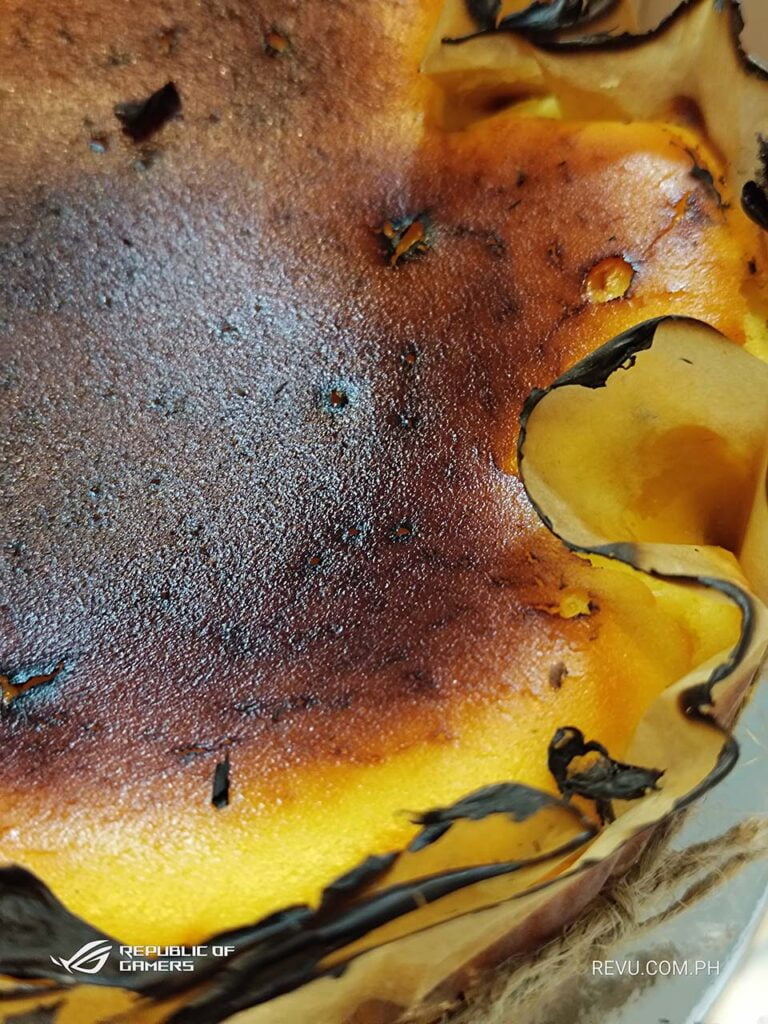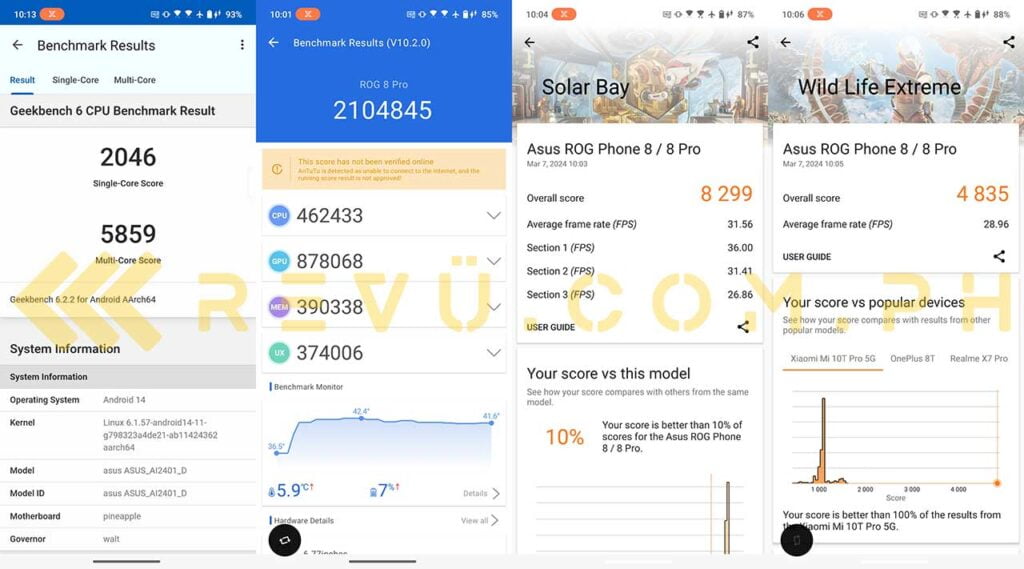The ROG Phone 8 and ROG Phone 8 Pro were announced back in January at CES 2024 in Las Vegas, where ASUS introduced the biggest facelift and camera update to its gaming-focused smartphone series in years.
We’ve been using the ASUS ROG Phone 8 Pro for weeks now, and we can confidently say that the Taiwanese company’s latest gaming phone does fully live up to the hype as one of the fastest — if not the fastest — Androids you can get your hands on right now.
In the Philippines, the ROG Phone 8 Pro has a suggested retail price of P75,995 (around $1,361 converted) for 24GB of RAM and 1TB of storage, while the 16GB/512GB model costs P60,995 ($1,093).
The top-of-the-line variant we tested has been kitted with a whopping 24GB of LPDDR5X RAM and 1TB of UFS 4.0 storage is certainly in a league of its own as far as mobile devices go. Never mind that it also comes with Qualcomm’s greatest and latest Snapdragon 8 Gen 3 chipset under the hood.
Unrivaled performance in the Android landscape
ASUS touts impressive performance improvements within the ROG Phone 8 Pro. Internal testing indicates a 30% CPU speed increase and a 25% GPU speed boost over the previous generation. These gains result in smoother everyday use, more responsive gaming, and overall greater computational capabilities for demanding users.
Our testing revealed that this Pro literally obliterates every single Android device we’ve ever used in the gaming and benchmarks department. It consistently outperforms all competitors in established benchmarks designed to assess mobile graphical processing capabilities. These results translate into a tangible in-game advantage. Users can expect smoother frame rates, sharper visuals, and a more responsive gameplay experience, particularly in graphically demanding titles.
Furthermore, the ASUS ROG Phone 8 Pro demonstrates exceptional high refresh-rate handling. This leads to butter-smooth visuals during fast-paced gameplay, minimizing screen tearing and ensuring that on-screen actions precisely reflect user input. This responsiveness is crucial for competitive gamers where even the slightest delay can mean the difference between victory and defeat.
And the thermals are great, too. Not earth-shattering stuff, but it’s good enough to keep the phone performing at a high level for extended periods, especially with the bundled AeroActive Cooler X clipped on.
Compared to its predecessor, the AeroActive Cooler 7, the AeroActive Cooler X has shrunk by 29% in overall volume and 10% in weight, demonstrating a shift towards lightweight design. Unfortunately, this revision comes with a couple of tradeoffs, notably the loss of four programmable shoulder buttons. The previously integrated subwoofer is absent from the latest iteration as well.

Thankfully, the core elements of the AeroActive Cooler design remain, including the active peltier cooler, RGB lighting, kickstand, and passthrough USB-C and 3.5mm ports.
While the rear chassis temperature becomes noticeably elevated during prolonged gaming and stress tests, the device’s passive cooling system has been improved. It now comes with an additional copper heatsink layer designed to pull heat away from the mainboard and dump it into the rear panel of the ROG Phone 8 Pro.
Our thermal-throttling test results indicate that the smartphone’s advanced cooling system effectively mitigates performance degradation under sustained loads, minimizing in-game framerate drops and slowdowns during extended sessions.
On paper, the ROG Phone 8 marks a departure from the brand’s history of monstrous batteries. The 5,500mAh cell is a step down from its predecessors’ 6,000mAh battery. This compromise is likely a nod to the handset’s slimmer, more lightweight design.
ASUS is touting exceptional battery life figures for its newest gaming-focused model. The firm asserts the device can deliver up to 22.7 hours of continuous Netflix streaming, 17 hours of Instagram browsing, and 14.4 hours of TikTok consumption on a single charge. Interestingly, these endurance claims come despite a reduction in battery capacity. The company has addressed this by emphasizing optimizations throughout the unit, promising overall battery endurance “within a 2% difference” of the ROG Phone 7 series.
The good news is that the battery life is not an issue with the ASUS ROG Phone 8 Pro. The use of a more efficient LTPO screen and chipset, along with extensive software refinements, likely contribute to these figures.
The new Pro maintains the 65-watt wired-charging standard of its predecessor. ASUS touts a 0% to 100% charge time of 39 minutes, which is somewhat inflated compared to real-world results. Based on our testing, a full charge usually takes around 45 minutes, with 50% reached in 15 minutes. Still, these are commendable results.
Those who have long bemoaned the absence of wireless charging on ROG Phone models will be happy to know that ASUS has finally addressed it with 15-watt Qi charging on the ROG Phone 8 lineup.
Gaming power meets sleek design
ASUS continues to overhaul the aesthetics of its groundbreaking ROG Phone line, and the ROG Phone 8 series marks a major departure from its predecessors. The aggressively “gamery” aesthetic has all but vanished, replaced by a minimalist slab design that hints at its potent capabilities rather than shouting them. Some users may miss the ROG Phone’s traditional and bolder styling, but ASUS’ decision to target a wider audience is strategically sound.
A notable design element is the device’s AniMe VISION feature, which is new and something we haven’t seen before. Instead of a dedicated rear display, the ROG Phone 8 Pro boasts a 341 Mini-LED programmable matrix with a 254 x 128-pixel resolution supporting black-and-white GIF animations that seamlessly disappear when turned off.
There are over 20 preloaded animations, some triggered by basic smartphone actions like using the camera, and you have the flexibility to import your own creations if you want to. A playful touch: Tapping two ASUS ROG Phone 8 Pro devices together unlocks exclusive animations. Of course, the system goes beyond visuals, displaying useful information like time, weather, and battery level.
The ROG Phone lineup has a history of delivering top-tier build quality, and the ROG Phone 8 Pro doesn’t disappoint. It raises the bar even, offering IP68 dust and water resistance — a first in the category. The tradeoff is the omission of the AeroActive Portal cooling vent found on the ROG Phone 6D Ultimate and ROG Phone 7 Ultimate.
The body is reassuringly rigid, with no signs of flex or hollow spots. Both front and rear panels incorporate Gorilla Glass (Victus 2 on the front), while the sturdy middle frame uses aluminum.
ASUS remains consistent and deliberate with the ROG Phone 8 Pro’s physical controls and ports. While the overall layout will be familiar to mobile gamers, several key design choices are worth noting.
The signature side port returns, offering an alternative, optimized connection point for wired peripherals. This USB-C port boasts USB 3.1 Gen 2 transfer speeds compared to the standard USB 2.0 on the phone’s bottom-mounted Type-C port. If you own a compatible external display, it supports DisplayPort 1.4 for video-out, too, allowing you to output up to 4K at 30Hz, 1440p at 75Hz, or 1080p at 144Hz — a boon for competitive play.
The side port, coupled with the welcome return of the AirTrigger ultrasonic shoulder buttons and 3.5mm audio jack signifies ASUS’ continued understanding of the hardcore mobile gamer’s needs.
The ROG Phone 8 series represents a shift in priorities for ASUS, with the company favoring slimmer display bezels over the audio prowess of previous generations. The 6.78-inch display now features a punch-hole camera for selfies and gains an impressive 94% screen-to-body ratio for a more immersive viewing experience. It retains an FHD+ resolution, delivering a pixel density of 395 dots per inch. Meanwhile, the 165Hz refresh rate and 720Hz touch sampling combine to provide unparalleled responsiveness that gamers demand.
The ROG Phone 8 Pro maintains Samsung’s E6 flexible AMOLED panel with HDR10+ support and Widevine L1 DRM certification. LTPO technology, which is new to the series, enables dynamic refresh rate adjustments between 1Hz and 120Hz for power efficiency without sacrificing fluidity. The absence of Dolby Vision is a minor omission.

In pursuit of the ever-diminishing bezel, ASUS has made a notable sacrifice: a departure from the ROG Phone’s powerful dual front-facing-speaker setup. While a stereo-speaker configuration remains, the revised speaker arrangement sees a bottom-firing linear speaker paired with a smaller — and noticeably weaker — front-facing unit. Don’t get us wrong; the output still sounds great in person. But the downgrade is there, if you care enough to hear it and compare with older models.
ASUS continues to bolster the ROG Phone 8 Pro’s audio with features. The ongoing partnership with DIRAC ensures Hi-Res Audio (HRA) and Hi-Res Audio Wireless certifications. Additionally, the ROG Phone 7’s Dirac Virtuo spatial audio-enhancement technology remains, offering software-based spatialization effects when using headphones. Comprehensive support for Bluetooth audio codecs, including aptX adaptive, aptX Low Latency, aptX Lossless Audio, LDAC, and AAC, further rounds out the package.
Finally, the camera isn’t an afterthought
The ROG Phone typically treats the camera as an afterthought. Thankfully, the ASUS ROG Phone 8 Pro marks a significant departure and packs the series’ best-performing camera yet. No longer relying on recycled sensors, the manufacturer has finally invested in a competent triple-camera setup. And rightfully so. Any flagship that hopes to compete with the likes of the Apple iPhone 15 and Samsung Galaxy S24 series must deliver excellent imaging performance both in terms of photo and video.
ASUS has opted to upgrade the camera block of the ROG Phone 8 family, with the Pro variant, in particular, sporting a dedicated telephoto option that replaces the filler macro lens on previous models.
The gaming phone even boasts the Taiwanese company’s new — and very effective — Hybrid Gimbal Stabilizer 3.0 system, an improved version of the Zenfone 10’s Hybrid Gimbal Stabilizer 2.0. This enables the HyperSteady stabilization option when shooting handheld video, meaning you can shoot perfectly stable content for social media and YouTube without the help of an external gimbal or third-party software. You can even slow the footage to about 40% of its original speed, since HyperSteady works even when recording 1080p video at 60 FPS.
The main 50-megapixel shooter gets the biggest upgrade. Out goes the aging Sony IMX766 image sensor, replaced by the significantly larger and better-performing Sony IMX890 sensor. This Quad-Bayer unit can bin down to 12.5 megapixels for improved detail and dynamic range, or churn out full 50-megapixel shots. It’s paired with an f/1.9 aperture lens.














Sample shots
Another notable addition is the new 3x telephoto. It uses a 32-megapixel Quad-Bayer sensor, and bins down to 8 megapixels for improved image quality. It offers up to 30x digital zoom, along with optical image stabilization and support for their Super Night mode.
The ultrawide rounds things out, seemingly recycled from its predecessors with a 13-megapixel sensor. Sadly, no autofocus, but its distortion-correcting lens is a nice feature.
Photos taken with the 50-megapixel camera shots look sharp at first glance, but tend to suffer from overprocessing, leading to blown highlights and excessive sharpening in some instances. The dedicated zoom camera delivers consistently pleasing results with sometimes better color and dynamic range than the primary shooter. The ultrawide thankfully matches the color signature of the other cameras and provides detailed results with sharp edges.
The 32-megapixel front-facing camera is above average, too, and benefits from a wider field of view than its predecessors. Skin tones look natural, though dynamic range could still be better.
Overall, we think the ROG Phone 8 series delivers a major camera upgrade, transforming it from a gaming-only device to a well-rounded daily driver. While imperfect, the new camera system is a solid contender and no longer a reason to avoid this otherwise mobile-gaming beast.
Final thoughts
Recognizing that dedicated gaming phones have a niche ceiling, the ASUS ROG Phone 8 Pro’s evolution into a mainstream flagship is not only smart but probably needed as well. It breaks through by shedding some gamer-specific quirks in favor of broader appeal, all without sacrificing its gaming prowess. Its more compact design with an IP68 rating and capable cameras make it a genuine contender for anyone who wants a powerful daily driver, not just committed mobile gamers.
Availability of the ASUS ROG Phone 8 Pro

ASUS ROG Phone 8 Pro specs
- 6.78-inch FHD+ LTPO E6 AMOLED display, 165Hz refresh rate, 2,500 nits peak brightness, Corning Gorilla Glass Victus 2
- 4nm Qualcomm Snapdragon 8 Gen 3 5G chipset
- Adreno 750 GPU
- 16GB/24GB LPDDR5X RAM
- 512GB/1TB UFS 4.0 storage
- Triple 50-megapixel main, 32-megapixel telephoto, and 13-megapixel ultrawide cameras
- 32-megapixel RGBW front camera
- Under-display fingerprint reader
- 5,500mAh battery
- 65-watt wired charging, 15-watt wireless charging
- 3.5mm audio port
- Dot matrix display
- Built-in gaming triggers
- Stereo speakers
- IP68 dust and water resistance
- Android 14 with ROG Armoury Crate
- Color: Phantom Black
Share this Post









